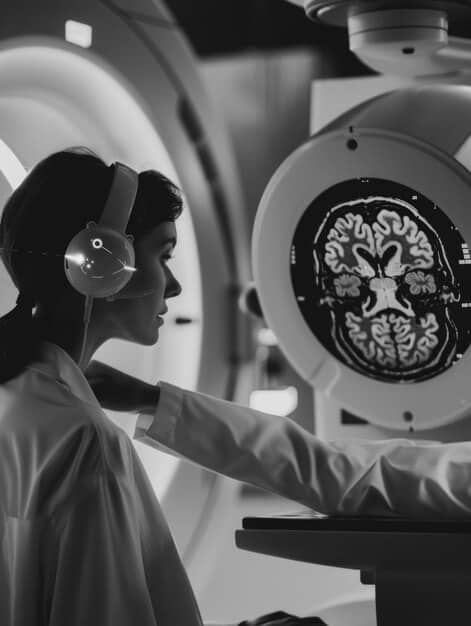Will Neuralink-Style Brain Implants Be Mainstream in the US by 2030?

Neuralink-style brain implants face significant hurdles in the US, including regulatory approvals, ethical concerns, and technological limitations, making mainstream adoption by 2030 highly improbable without major breakthroughs and shifts in public perception.
Are we on the cusp of a future where brain implants become commonplace? The idea of seamlessly merging technology with our minds has captured the imagination of many, fueled by companies like Neuralink. But will Neuralink-style brain implants be mainstream in the US by 2030?
The Current State of Brain Implant Technology
Brain-computer interfaces (BCIs) are no longer confined to science fiction. Today, they represent a rapidly evolving field with the potential to revolutionize how we interact with technology, treat neurological disorders, and even enhance human capabilities. Understanding the current state of this technology is essential for assessing its future prospects.
Existing Applications of BCIs
BCIs have already made significant inroads in medical applications, offering hope to individuals with severe disabilities.
- Restoring Motor Function: BCIs have enabled paralyzed individuals to control prosthetic limbs and regain some degree of movement.
- Treating Neurological Disorders: Deep brain stimulation (DBS), a form of BCI, is used to manage symptoms of Parkinson’s disease, epilepsy, and other neurological conditions.
- Communication Assistance: BCIs can help individuals with locked-in syndrome communicate by translating their brain activity into text or commands.
Challenges and Limitations
Despite the progress, BCIs face considerable challenges that need to be addressed before widespread adoption can occur.
- Invasiveness: Many BCIs require invasive surgical procedures to implant electrodes in the brain, posing risks of infection, bleeding, and other complications.
- Biocompatibility: Ensuring that the implanted materials are compatible with the brain’s delicate tissue and minimizing the risk of rejection are crucial.
- Signal Stability: Maintaining a stable and reliable connection between the brain and the BCI over long periods is a significant technical hurdle.

The current state of brain implant technology shows promise but also highlights the significant challenges that must be overcome. Advances in materials science, surgical techniques, and signal processing are essential to pave the way for safer, more effective, and more widely accessible BCIs.
Neuralink’s Approach and Innovations
Neuralink, founded by Elon Musk, has set ambitious goals for developing advanced BCIs. The company’s approach and innovations have generated considerable excitement and controversy within the scientific community and the general public.
Neuralink’s Technology
Neuralink’s BCI system consists of several key components designed to overcome the limitations of existing technologies.
- Ultra-thin Electrodes: Neuralink uses thousands of tiny, flexible electrodes that are less likely to damage brain tissue compared to traditional electrodes.
- Surgical Robot: A specialized surgical robot precisely inserts the electrodes into specific areas of the brain, minimizing invasiveness and improving accuracy.
- Wireless Data Transmission: The Neuralink device wirelessly transmits brain activity data to an external computer, eliminating the need for wires and reducing the risk of infection.
Neuralink’s Goals
Neuralink aims to develop BCIs for a wide range of applications, from treating neurological disorders to enabling human enhancement.
- Medical Applications: Neuralink’s initial focus is on developing BCIs to restore motor function, treat epilepsy, and address other neurological conditions.
- Human Enhancement: In the longer term, Neuralink envisions BCIs that can enhance cognitive abilities, improve memory, and enable direct brain-to-brain communication.
- Symbiosis with AI: Musk has emphasized the importance of BCIs in enabling humans to keep pace with the rapid advancements in artificial intelligence.
Neuralink’s approach and innovations have the potential to accelerate the development and adoption of BCIs. However, the company faces significant technical, ethical, and regulatory challenges that will need to be addressed before its vision can become a reality.
Regulatory Hurdles in the US
The regulatory landscape in the US plays a crucial role in determining the timeline for the approval and adoption of new medical technologies, including brain implants. Navigating this landscape can be a complex and lengthy process.
FDA Approval Process
In the US, brain implants are typically classified as Class III medical devices, which are subject to the most rigorous regulatory scrutiny by the Food and Drug Administration (FDA).
To obtain FDA approval, companies must demonstrate the safety and effectiveness of their devices through extensive preclinical and clinical trials. This process can take several years and require significant financial investment.
Ethical Considerations
The development and use of brain implants raise a host of ethical concerns that regulators must consider.
- Patient Safety: Ensuring the safety of patients undergoing BCI implantation is paramount. Regulators must carefully evaluate the risks and benefits of these devices.
- Data Privacy: BCIs generate vast amounts of sensitive brain activity data, raising concerns about privacy and security.
- Autonomy and Identity: Some ethicists worry that BCIs could alter individuals’ sense of self or compromise their autonomy.

The regulatory hurdles in the US are substantial and could significantly delay the widespread adoption of Neuralink-style brain implants. Addressing the ethical concerns and ensuring patient safety will be critical to gaining regulatory approval and public acceptance.
Public Perception and Acceptance
Even if the technological and regulatory hurdles are overcome, the widespread adoption of brain implants will depend on public perception and acceptance. Surveys and studies have revealed a range of attitudes toward BCIs, from enthusiasm to skepticism.
Concerns and Fears
Many people harbor concerns and fears about brain implants, including:
- Invasiveness: The idea of undergoing brain surgery can be daunting for many individuals.
- Security Risks: Concerns about hacking and data breaches are prevalent.
- Ethical Implications: Some worry about the potential for misuse or abuse of BCI technology.
Potential Benefits
On the other hand, many people are excited about the potential benefits of brain implants, such as:
The public’s perception and acceptance of brain implants will depend on addressing the concerns and highlighting the potential benefits. Open and transparent communication, along with robust ethical guidelines, will be essential to fostering trust and encouraging adoption.
Alternative Technologies and Approaches
While Neuralink has garnered significant attention, it is essential to recognize that other companies and research institutions are pursuing alternative technologies and approaches to BCIs. These alternatives may offer advantages in terms of safety, cost, or functionality.
Non-Invasive BCIs
Non-invasive BCIs, such as those based on electroencephalography (EEG), do not require surgical implantation. While they may offer lower signal resolution, they are generally considered safer and more accessible.
One of the advantages of non-invasive BCIs is that they are easier to test and refine to the point where they may provide positive outcomes without the use of invasive procedures. The primary disadvantage, they are less precise than invasive methods and are limited in the types of signals they can detect due to the skull blocking much of the signal.
Gene Therapy
Researchers are exploring the use of gene therapy to enhance brain function and treat neurological disorders. While still in the early stages of development, this approach could offer a less invasive alternative to traditional brain implants.
药物疗法
Pharmaceutical approaches to improving cognitive functions are available with differing levels of success. With the continued development of this field it is possible more precise drugs will be used with the aim of enhancing specific functions.
While Neuralink is a prominent player in the field, alternative technologies and approaches to BCIs are being developed. These alternatives may offer advantages in terms of safety, cost, or functionality.
Timeline and Predictions for 2030
Given the current state of the technology, regulatory hurdles, public perception, and alternative approaches, what is the likelihood of Neuralink-style brain implants becoming mainstream in the US by 2030?
Optimistic Scenario
In an optimistic scenario, significant technological breakthroughs could accelerate the development and adoption of BCIs.
FDA approval processes could be streamlined, ethical guidelines could be established, and public acceptance could increase due to successful clinical trials and positive media coverage.
Pessimistic Scenario
In a pessimistic scenario, technical challenges, regulatory delays, and ethical concerns could hinder the progress of BCIs.
Public skepticism could persist, and alternative technologies could prove more viable.
Considering the various factors at play, it is unlikely that Neuralink-style brain implants will be mainstream in the US by 2030. However, it is possible that BCIs will become more widely used for specific medical applications and that alternative approaches will gain traction.
| Key Point | Brief Description |
|---|---|
| 🧠 BCI Technology | Brain-computer interfaces are advancing, aiding motor function and treating neurological disorders. |
| 🚀 Neuralink’s Goals | Aims to restore functions, enhance cognition, and enable AI symbiosis. |
| 🛡️ Regulatory Hurdles | FDA approval is a rigorous process due to safety, data, and ethical concerns. |
| 🤔 Public Perception | Concerns vary from invasiveness and security risks to excitement about potential benefits. |
FAQ
▼
Currently, brain implants are primarily used for medical purposes, such as restoring motor function in paralyzed individuals and managing symptoms of neurological disorders like Parkinson’s disease and epilepsy.
▼
Neuralink uses ultra-thin electrodes, a surgical robot for precise implantation, and wireless data transmission, aiming to reduce invasiveness and improve accuracy of brain-computer interfaces.
▼
Ethical concerns include patient safety during implantation, data privacy of brain activity data, and potential impacts on personal autonomy and identity from altered brain function.
▼
In the US, brain implants face rigorous FDA scrutiny as Class III medical devices. Companies must demonstrate safety and effectiveness through extensive pre-clinical and clinical trials, which can be lengthy.
▼
Yes, alternatives include non-invasive BCIs like EEG-based systems, gene therapy approaches to enhance brain function, and pharmaceutical solutions aimed at improving cognitive abilities.
Conclusion
While the prospect of widespread Neuralink-style brain implants in the US by 2030 is unlikely given current technological, regulatory, and ethical challenges, significant advancements and shifts in public perception could alter this trajectory. Continued research, transparent communication, and the development of robust ethical guidelines are crucial for realizing the potential benefits of BCIs while mitigating the risks.





